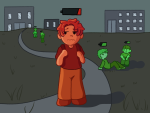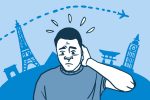Everyone has had a time in their life where they’ve looked at a class syllabus and saw “Participation” under the grading breakdown and died a little inside. However, forced participation is no surprise to most college students because teachers instill in their students at a young age that they need to speak up more and actively engage in the classroom.
But along the way, where did we go from encouraging participation to forcing it?
Forced participation is a common theme that most high schools and colleges utilize, as participation is a crucial part of socializing and a way for teachers to gauge the level of knowledge in their classes. Today, participating in class has become more of a hidden agenda from teachers and professors, who now make it a requirement or a grade in order to indirectly coerce students to participate.
Many students who suffer from social anxiety know that participating in class is a dreadful challenge, and those affected more often choose to lose that portion of their grade.
For those who are not quite sure of what social anxiety is, the Anxiety and Depression Association of America defines it as intense anxiety or fear of being judged, negatively evaluated or rejected in a social or performance situation. It affects over 15 million adults in the U.S. alone, but it predominately targets teenagers.
That said, social anxiety is different from just being shy because shyness will not completely inhibit you in your daily life. For some, social anxiety cripples them to the point where they are practically disabled in social situations.
If someone is shy, it is possible that they can exhibit symptoms of social anxiety, or in some cases, their shyness can lead to social anxiety, but for the most part, social anxiety doesn’t constrain people who are simply shy.
Although forced participation seems unjustifiable when you consider the students with severe social anxiety, some people still support it. In the arguments found in favor of forced participation, many point out that forced social interactions open students up and help them down the road.
Jessica Lahey is a high school teacher who is active about voicing her support for forced participation. She says, “As a teacher, it is my job to teach grammar, vocabulary and literature, but I must also teach my students how to succeed in the world we live in — a world where most people won’t stop talking. If anything, I feel even more strongly that my introverted students must learn how to self-advocate by communicating with parents, educators and the world at large.”
The main point Lahey makes is that speaking and social interaction are major parts of many careers. So, how can you expect to take up a proper job if you’re not able to interact or speak freely and professionally with others?
Although Lahey claims to sympathize with introverts and anxiety sufferers further on in the article, she maintains that you have to do what you have to do for the sake of your job and your life.
In regard to her own children, both present introverts, Lahey elaborates on getting kids more social at an earlier stage in order to be effective in the world. She says, “If you can’t speak up for yourself, if you can’t muster the courage to tell the person you love that you love them, if you can’t advocate for your own safety, the world will be a very intimidating and frightening place. I don’t want my kids to be intimidated by the world.”

Ultimately, for students who do not participate, their lack of engagement may raise a red flag for teachers and parents. After all, their silence in class reflects their individual personalities; they seem weak, unwilling to change inconveniences and content with living with a thorn in their side rather than willing to speak up or act to alter that.
At the end of the day, standing up for yourself is certainly an empowering skill to learn and is a justifiable reason to want to force participation, starting with minuscule methods in the classroom.
However, the majority of opinions are voting in opposition to forced participation. People with social anxiety choose not to participate for many reasons, including the fear of being ridiculed or saying something dumb that they will beat themselves up over later.
Classrooms themselves become frenzied, competitive spaces when participation is required, as more outspoken students fight to speak the correct answer into existence. The chaotic atmosphere further impairs kids with social anxiety, as they feel as though they are unable to match those standards.
Commonly, students may force themselves to speak, as well. When there’s a grade hanging over your head, you become desperate and throw yourself into the fray without completely thinking it through or even overthinking it, and sometimes it becomes a mess.
Those who suffer from social anxiety hone in more on what they need to say, and in turn, they tend to tune out the rest of the conversation around them, which impairs their learning experience later on.
Students who have social anxiety do not lack interpersonal communication, which is a common misconception. Some better express themselves through writing or other methods. When they have time to reflect and think their responses through, they are better able to express their thoughts and emotions of their own free will.
The learning environment is a very cookie-cutter space, with structured methods and concepts to cater to the general population. To combat the problem of forced participation for students with social anxiety, the general consensus is that teachers and professors should tailor the learning environment to the student. Tara Malone, a writer for Introvert, Dear, weighs in based on her own personal experience.
She elaborates that teachers should remain attuned to quieter students instead of passing over them. She also asks them to look for encouraging signs of engagement that go beyond class participation. Take into account the other aspects in class, such as turning in assignments on time, the quality of said assignments and their attentiveness in class.
Speaking with students outside of class to propose an alternate solution to their struggle with participation is something to consider. By determining another way to calculate their participation grade, teachers can put students at ease, and they give them the power to elaborate what they want to say.
Lastly, Malone encourages teachers and professors to avoid viewing social anxiety as a completely negative aspect that society needs to eradicate; instead, it should be something to embrace.
Social anxiety sufferers have a lot to contribute in class, yet feel restrained by their own minds. By working alongside them instead of against them, it can lead to fruitful results and can change their lives for the better.

















